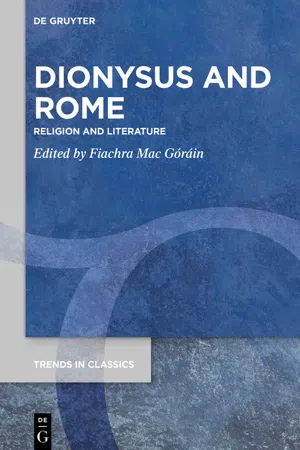
Dionysus and Rome
Religion and Literature
Fiachra Mac Góráin, Fiachra Mac Góráin
- 260 pages
- English
- ePUB (adapté aux mobiles)
- Disponible sur iOS et Android
Dionysus and Rome
Religion and Literature
Fiachra Mac Góráin, Fiachra Mac Góráin
À propos de ce livre
While most work on Dionysus is based on Greek sources, this collection of essays examines the god's Roman and Italian manifestations.
Nine contributions address Bacchus' appearance at the crossroads of Greek and Roman cultures, tracing continuities and differences between literary and archaeological sources for the god. The essays offer coverage of Dionysus in Roman art, Italian epigraphy; Latin poetry including epic, drama and elegy; and prose, including historiography, rhetorical and Christian discourse.
The introduction offers an overview of the presence of Dionysus in Italy from the archaic to the imperial periods, identifying the main scholarly trends, with treatment of key Dionysian episodes in Roman history and literature. Individual chapters address the reception of Euripides' Bacchae across Greek and Roman literature from Athens to Byzantium; Dionysus in Roman art of the archaic and Augustan periods; the god's relationship with Fufluns and Liber in the 4th and 3rd centuries BCE; Dionysian associations; Bacchus in Cicero; Ovid's Tristia 5.3; Bacchus in the writings of Christian Latin writers.
The collection sheds light on a relatively understudied aspect of Dionysus, and will stimulate further research in this area.
Foire aux questions
Informations
Index of inscriptions and visual artefacts
- Inscriptions
- CIE 10985 1
- CIE 11073 1
- CIE 11101 1
- CIE 11110 1
- CIE 8079 1
- CIL 12.561 = ILLRP 1197= ILS 8562 1
- CIL 12.563 1
- CIL 6.1285 1
- CIL 12 2.581 = ILLRP 511 = ILS 18 (SC de Bacchanalibus) 1, 2, 3, 4, 5, 6, 7, 8, 9, 10
- CSE DDR 1, 5 1
- CSE Italia 1, I, 10 1
- CSE Italia 6, 83 = CIL 12 2498 1
- IGUR I 160 1, 2
- SEG 4.92 1
- SIG3 648B 1, 2
- Visual artefacts
- Apulian phiale (BM F133) 1
- Ara Pacis Augustae 1, 2
- BCM Athens 376 1
- Berlin, Charlottenburg, inv. Misc. 6239 1
- Cista Ficoroni 1, 2
- Copenhagen, Ny Carlsberg Glyptotek, inv. HIN 26 1
- Lanuvium, Museo Civico, fresco fragment 1, 2
- Naples, Museo Archeologico Nazionale, inv. 100019 1
- Pompeii, House of the Centaur (VI.9.3–5) 1
- Pompeii, Villa of the Mysteries 1, 2, 3, 4
- Rome, Musei Capitolini, Antiquarium Comunale, statue fragments 1, 2
- Rome, Museo Nazionale Etrusco di Villa Giulia, inv. 24787 1
- Rome, Museo Nazionale Romano, inv. 1037, 1071, 1072 1, 2
- Rome, Museo Palatino, inv. 601 and 614 1
- Rome, Villa della Farnesina 1, 2, 3, 4, 5, 6
- Rome, Villa Doria Pamphili 1, 2
- Saint Petersburg, Hermitage Museum, inv. 18.832 1
Table des matières
- Cover
- Title Page
- Copyright
- Preface
- Contents
- List of illustrations
- List of contributors
- Introduction. Dionysus in Rome: accommodation and resistance
- The ancient reception of Euripides’ Bacchae from Athens to Byzantium
- Images of Dionysus in Rome: the archaic and Augustan periods
- Liber, Fufluns and the others: rethinking Dionysus in Italy between the fifth and the third centuries BCE
- Dionysian associations and the Bacchanalian affair
- Dionysus / Bacchus / Liber in Cicero
- Bacchus and the exiled Ovid (Tristia 5.3)
- Alius furor. Statius’ Thebaid and the metamorphoses of Bacchus
- The shadow of Bacchus:Liber and Dionysus in Christian Latin literature (2nd–4th centuries)
- Index rerum et nominum
- Index locorum
- Index of inscriptions and visual artefacts